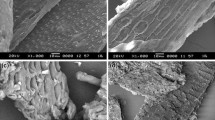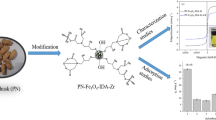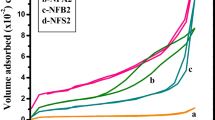Abstract
Rice husk is a biodegradable polymer which is quite abundant. However, its low adsorption capacity has limited its use as an adsorbent. This study has described the adsorption of methyl orange (MO) on rice husk (RH) and its H3PO4-functionalized derivative (FRH). Both adsorbents were characterized by Fourier transform infrared spectroscopy (FTIR), scanning electron microscopy (SEM) and Energy Dispersive X-ray (EDX). Spectra data showed shifts and reduction in intensities of functional groups in addition to appearance of a peak at 963 cm−1 in FRH. SEM and EDX images revealed changes in surface morphology with rougher cavities and increased percentage of carbon content that could influence adsorptive properties. Effects of pH, contact time, MO concentrations, adsorbent dosage, and temperatures on adsorption processes were studied. Adsorptive uptake of MO was maximum at pH 2.0 for RH, pH 5.0 for FRH, and was found to increase with increase in contact time, dosage and concentration. Langmuir isotherm was the most favourable to describe the adsorption process for RH whereas Freundlich was the most appropriate for FRH. The maximum monolayer adsorption capacity improved from 28.7 (RH) to 177.4 mgg−1 (FRH). Energies of adsorption (4.5 and 3.6 kJmol−1) indicated a physiosorption removal of MO. Pseudo second order kinetics best described the adsorption process. Both adsorption processes were spontaneous, while it was exothermic for RH, it was endothermic for FRH. Functionalization with H3PO4 enhanced the adsorptive capacity of rice husk by 519%.













Similar content being viewed by others
Abbreviations
- RH:
-
Rice husk
- FRH:
-
Functionalized rice husk
- MO:
-
Methyl orange
- FTIR:
-
Fourier transform infrared spectroscopy
- SEM:
-
Scanning electron microscopy
- EDX:
-
Energy dispersive X-ray
References
Azeez L, Lateef A, Adebisi SA, Oyedeji AO (2018) Novel biosynthesized silver nanoparticles from cobwebas adsorbent for Rhodamine B: equilibrium isotherm, kinetic and thermodynamic studies. Appl Water Sci 8:32. https://doi.org/10.1007/s13201-018-0676-z
Zhao D, Zhang W, Chena C, Wang X (2013) Adsorption of methyl orange dye onto multiwalled carbon nanotubes. Procedia Environ Sci 18:890–895
Allouche F-N, Yassaa N, Lounici H (2015) Sorption of methyl orange from aqueous solution of chitosan biomass. Procedia Earth Planetary Sci 15:596–601
Youssef NA, Shaban SA, Ibrahim FA, Mahmoud AS (2016) Degradation of methyl orange using Fenton catalytic reaction. Egypt J Petroleum 25:317–321
Huang R, Liu Q, Huo J, Yang B (2017) Adsorption of methyl orange onto protonated crosslinked chitosan. Arab J Chem 10:24–32
Keyhanian F, Shariati S, Faraji M, Hesabi M (2016) Magnetite nanoparticles with surface modification for removal of methyl violet from aqueous solutions. Arab J Chem 9:S348–S354
Rattanapan S, Srikram J, Kongsune P (2017) Adsorption of methyl orange on coffee grounds activated carbon. Energy Proc 138:949–954
Ojedokun AT, Bello OS (2017) Liquid phase adsorption of Congo red dye on functionalized corn cobs. J Dispersion Sci Technol 38(9):1285–1294
Ojo TA, Ojedokun AT, Bello OS (2019) Functionalization of powdered walnut shell with orthophosphoric acid for congo red dye removal. Particlate Sci Technol 37(1):74–85
Shah J, Jan MR, Haq A, Khan Y (2012) Removal of Rhodamine B from aqueous solutions and wastewater by walnut shells: kinetics, equilibrium and thermodynamics studies. Front Chem Sci Eng 7(4):428–436
Bazrafshan E, Zarei AA, Nadi H, Zazouli MA (2014) Adsorptive removal of methyl orange and reactive red 198 dyes by Moringa peregrina ash. Indian J Chem Technol 21:105–113
Li WC, Law FY, Chan YHM (2017) Biosorption studies on copper (II) and cadmium (II) using pretreated rice straw and rice husk. Environ Sci Pollut Res 24(10):8903–8915
El Haddad M, Mamouni R, Saffaj N, Lazar S (2016) Evaluation of Performance of animal bone meal as a new low cost adsorbent for the removal of a cationic dye Rhodamine B from aqueous solutions. J Saudi Chem Soc 20:S53–S59
Shen K, Gondal MA (2017) Removal of hazardous Rhodamine dye from water by adsorption onto exhausted coffee ground. J Saudi Chem Soc 21:S120–S127
Aishah AJ, Sugeng TS, Hazirah A, Rahim ND, Arif M, Aziz A (2010) Adsorption of methyl orange from aqueous solution onto calcined Lapindo volcanic mud. J Hazard Mater 181:755–762
Tang J, Yang ZF, Yi YJ (2012) Enhanced adsorption of methyl orange by vermiculite modified by cetyltrimethylammonium bromide (CTMAB). Procedia Environ Sci 13:2179–2187
Haitham K, Razak S, Nawi MA (2019) Kinetics and isotherm studies of methyl orange adsorption by a highly recyclable immobilized polyaniline on a glass plate. Arab J Chem 12(7):1595–1606
Istratie R, Stoia M, Pacurariu C, Locovei C (2019) Single and simultaneous adsorption of methyl orange and phenol onto magnetic iron oxide/carbon nanocomposites. Arabian J Chem 12(8):3704–3722
Raliya R, Avery C, Chakrabarti S, Biswas P (2017) Photocatalytic degradation of methyl orange dye by pristine titanium dioxide, zinc oxide, and graphene oxide nanostructures and their composites under visible light irradiation. Appl Nanosci 7:253–259
Syuhadah SN, Rohasliney H (2012) Rice husk as biosorbent: a review. Heal Environ J 3:89–95
Lattuada RM, Peralba MCR, Dos Santos JHZ, Fisch AG (2014) Rice husk and rice husk carbon as low- cost adsorbents for metals from acidic aqueous solutions. Sep Sci Tech 49:101–111
Zhang Y, Zhao J, Jiang Z, Shan D, Lu Y (2014) Biosorption of Fe (II) and Mn (II) ions from aqueous solution by rice husk ash. Biomed Res Int. https://doi.org/10.1155/2014/973095
Anjum H, Murugesan T (2016) Effect of functionalization condition on characterization of carbonaceous adsorbent. Proc Eng 148:1346–1350
Masih M, Anthony P, Siddiqui SH (2018) Removal of Cu (II) ion from aqueous solutions by rice husk carbon-chitosan composite gel (CCRH) using response surface methodology. Environ Nanotechnol Monitor Manage 10:189–198
Inyinbor AA, Adekola FA, Olatunji GA (2016) Kinetics and isothermal modelling of liquid phase adsorption of Rhodamine B onto urea modified Raphia hookerie epicarp. Appl Water Sci 7(6):3257–3266
Chen RP, Zhang YL, Shen LF, Wang XY, Chen JQ, Ma AJ, Jiang WM (2015) Lead (II) and methylene blue removal using a fully biodegradable hydrogel based on starch immobilized humic acid. Chem Eng J 268:348–355
Chowdhury S, Saha PD (2012) Biosorption of methylene blue from aqueous solutions by a waste biomaterial: hen feathers. Appl Water Sci 2:209–219
Abdel-Halim ES (2013) Preparation of starch/poly (N, N-Diethylaminoethyl methacrylate) hydrogel and its use in dye removal from aqueous solutions. React Funct Polym 73:1531–1536
Amuda OS, Olayiwola AO, Alade AO, Farombi AG, Adebisi SA (2014) Adsorption of methylene blue from aqueous solution using steam-activated carbon produced from Lantana camara stem. J Environ Protect 5:1352–1363
Olajire AA, Abidemi JJ, Lateef A, Benson NU (2017) Adsorptive desulphurization of model oil by Ag nanoparticles-modified activated carbon prepared from brewer’s spent grains. J Environ Chem Eng 5:147–159
Girish CR, Murty VR (2014) Adsorption of phenol from aqueous solution using Lantana camara, forest waste: kinetics, isotherm, and thermodynamic studies. Int Sch Res Notices. https://doi.org/10.1155/2014/201626
Zhou Y, Zhang F, Tang L, Zhang J, Zeng G, Luo L, Liu Y, Wang P, Peng B, Liu X (2017) Simultaneous removal of atrazine and copper using polyacrylic acid functionalized magnetic ordered mesoporous carbon from water: adsorption mechanism. Sci Reports 7:43831. https://doi.org/10.1038/srep43831
Langmuir I (1918) The adsorption of gases on plane surfaces of glass, mica and platinum. ACS 40:1361–1403
Freundlich HMF (1906) Over the adsorption in solution. J Phys Chem 57:385–470
Tempkin MI, Pyzhev V (1940) Kinetics of ammonia synthesis on promoted iron catalyst. Acta Phys Chim USSR 12:327–356
Dubinin MM, Radushkevich LV (1947) The equation of the characteristic curve of the activated charcoal. Proc Acad Sci USSR Phys Chem Sect 55:331–337
Zhu HY, Jiang R, Fu YQ, Jiang JH, Xiao L (2011) Preparation, characterization and dye adsorption properties of γFe2O3/SiO2/chitosan composite. Appl Surf Sci 258:1337–1344
Willie C, Hosseini S, Moonis AK, Chuah TG, Thomas SYC (2013) Acid modified carbon coated monolith for methyl orange adsorption. Chem Eng J 215–216:747–754
Kou T, Wang Y, Zhang C, Sun J, Zhang Z (2013) Adsorption behaviour of methyl orange onto nanoporous core-shell Cu@Cu2O nanocomposite. Chem Eng J 223:76–83
Xu J, Chena L, Qu H, Jiao Y, Xie J, Xing G (2014) Preparation and characterization of activated carbon from reedy grass leaves by chemical activation with H3PO4. Appl Surf Sci 320:674–680
Yorgun S, Yıldız D (2015) Preparation and characterization of activated carbons from Paulownia wood by chemical activation with H3PO4. J Taiwan Inst Chem Eng 53:122–131
Duan X, Srinivasakannan C, Wang X, Wang F, Liu X (2017) Synthesis of activated carbon fibers from cotton by microwave induced H3PO4 activation. J Taiwan Inst Chem Eng 70:374–381
Kumar A, Jena HM (2016) Preparation and characterization of high surface area activated carbon from Fox nut (Euryale ferox) shell by chemical activation with H3PO4. Res Phy 6:651–658
Shamsuddin MS, Yusoff NRN, Sulaiman MA (2016) Synthesis and characterization of activated carbon produced from kenaf core fiber using H3PO4 activation. Procedia Chem 19:558–565
Yakout SM, Sharaf El-Deen G (2016) Characterization of activated carbon prepared by phosphoric acid activation of olive stones. Arab J Chem 9:S1155–S1162
Adekola FA, Ayodele SB, Inyinbor AA (2019) Efficient rhodamine B removal using acid- and alkaline-activated Musa paradisiaca Biochar. Pol J Environ Stud 28(5):3063–3070
Macías-García A, Carrasco-Amador JP, Encinas-Sánchez V, Díaz-Díeza MA, Torrejón-Martín D (2019) Preparation of activated carbon from kenaf by activation with H3PO4. Kinetic study of the adsorption/electroadsorption using a system of supports designed in 3D, for environmental applications. J Environ Chem Eng. 7:103196
Oyelude EO, Awudza JAM, Twumasi SK (2018) Removal of malachite green from aqueous solution using pulverized teak leaf litter: equilibrium, kinetic and thermodynamic studies. Chem Central J 12:81. https://doi.org/10.1186/s13065-018-0448-8
Azeez L, Lateef A, Adejumo AL, Adeleke JT, Adetoro RO, Mustapha Z (2020) Adsorption behaviour of rhodamine B on hen feather and corn starch functionalized with green synthesized silver nanoparticles (AgNPs) mediated with cocoa pods extracts. Chem Afr 3:237–250
Dada AO, Ojediran JO, Olalekan AP (2013) Sorption of Pb2+ from aqueous solution unto modified rice husk: isotherms studies. Adv Phys Chem. https://doi.org/10.1155/2013/842425
Paethanom A, Yoshikawa K (2012) Influence of pyrolysis temperature on rice husk char characteristics and its tar adsorption capability. Energies 5:4941–4951
Dada AO, Olalekan AP, Olatunya AM, DADA O (2012) Langmuir, Freundlich, Temkin and Dubinin–Radushkevich Isotherms Studies of Equilibrium Sorption of Zn2+ Unto Phosphoric Acid Modified Rice Husk. IOSR J Appl Chem. 3(1): 38-45
Author information
Authors and Affiliations
Corresponding author
Ethics declarations
Conflict of interest
Authors report no conflict of interest.
Rights and permissions
About this article
Cite this article
Azeez, L., Adejumo, A.L., Asaolu, S.S. et al. Functionalization of Rice Husks with Ortho-Phosphoric Acid Enhanced Adsorptive Capacity for Anionic Dye Removal. Chemistry Africa 3, 457–467 (2020). https://doi.org/10.1007/s42250-020-00142-7
Received:
Accepted:
Published:
Issue Date:
DOI: https://doi.org/10.1007/s42250-020-00142-7




